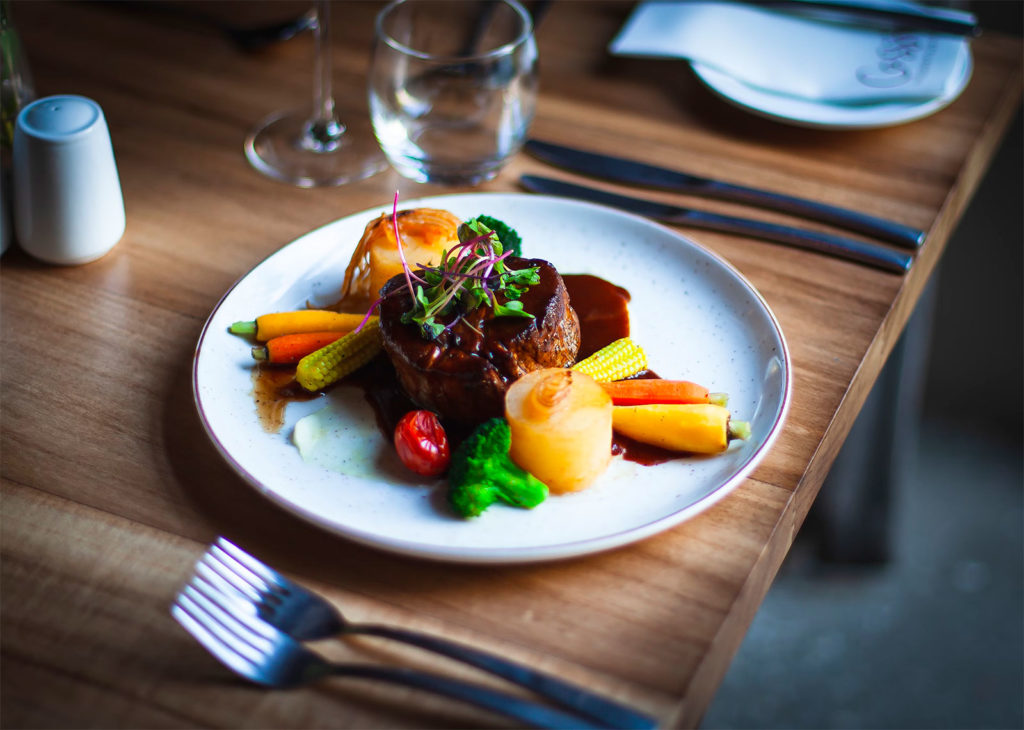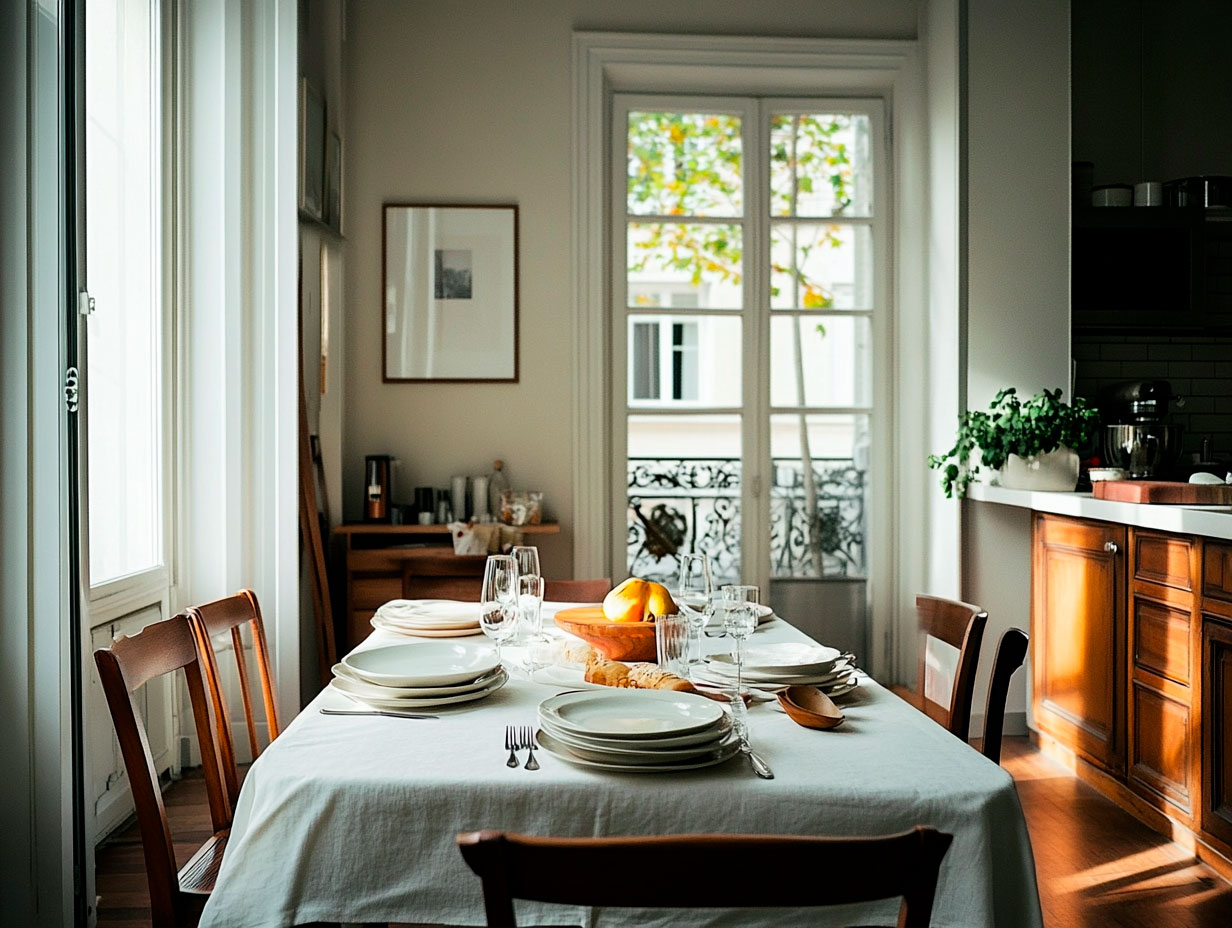Understand the unwritten etiquette of a French family meal. Learn how food in France is shared, served, and respected at the table.
Eating in France is a social ritual
A French meal is not just about food. It reflects habits rooted in history, family tradition, and social codes. Eating in France often takes place in a shared space where the meal is served in courses and conversations follow an unspoken rhythm. A traditional French family meal usually happens at home, especially on Sundays or holidays, and can last between 1.5 to 3 hours. Each step of the meal follows certain expectations, which are rarely written but widely respected.
These unspoken rules are passed on through observation and imitation, especially in family circles. They shape how people behave from the moment they sit at the table to the end of the meal. Not following them may not offend directly, but it can mark someone as unfamiliar with local culture.

Setting the table and taking your seat
The arrangement of the table matters
In French homes, table setting follows a standard structure. The fork is placed to the left of the plate, the knife to the right, with the cutting edge facing the plate. Glasses are placed above the plate, generally one for water and one for wine. Napkins are folded simply, either placed on the plate or to the left of the fork.
Bread is not placed on a bread plate, but directly on the tablecloth, to the left of the main plate. This tradition goes back to rural customs and remains widely practiced. Water is often served in a carafe, while wine is brought out with the main course if appropriate.
Seating follows social codes
The host or hostess usually decides where everyone sits. The most honoured guest may sit opposite the host or to their right. Children are often grouped together. Changing seats or sitting before the host invites you to can be seen as impolite.
The structure of a traditional French meal
Courses follow a fixed order
A traditional French family meal usually has five parts:
- Apéritif (optional): light drinks with snacks served in the living room.
- Entrée: a starter, often cold, such as salad, pâté or soup.
- Plat principal: the main course, often meat or fish with vegetables.
- Fromage: served on a separate plate, often accompanied by bread.
- Dessert: fruit tart, cake, or yogurt.
- Café: black coffee, without milk or sugar by default.
Meals are served in courses rather than all at once. This allows the pace to slow down, encouraging conversation and time spent together.
Timing is important
Meals are typically eaten at set times: lunch at 12:30 to 13:30, dinner at 19:30 to 20:30. Eating outside of these hours, especially full meals, is rare in family settings. It is considered odd to snack between meals, especially in front of others.

Behaviour at the table: what is expected
Hands above the table, not on your lap
In French tradition, it is expected that hands remain visible on the table, usually resting the wrists near the edge. This old custom is based on trust and formality. Hiding hands in one’s lap is considered inappropriate or suspicious.
Wait before starting to eat
You are expected to wait until everyone is served and the host says “Bon appétit” before starting. Eating before others are served is rare and might be frowned upon.
Children are taught from an early age to wait, to chew quietly, and to sit still. Conversation is encouraged, but loud or interruptive behaviour is discouraged.
No sharing plates or adding seasoning immediately
Asking to share food or take food from someone else’s plate is not common. It may be acceptable among close family members, but it is not the norm.
Adding salt, pepper, or sauce before tasting the food can also be seen as a critique of the cook’s preparation. It is polite to try the food first.
Serving and passing food
The host usually serves the dishes
In a traditional French home, the person who cooked often serves the food. Guests rarely serve themselves unless the host offers the dish around. Serving yourself without being invited may seem informal or abrupt.
Bread is placed directly on the table
Bread is passed around, and it is polite to take a piece and place it directly on the tablecloth, not on your plate. Butter is rarely served with bread during a meal, unless it is part of a specific dish or starter.
Cheese etiquette is precise
When cheese is served, you are expected to cut a proper portion. For round cheeses, cut like a slice of pie. For wedge-shaped cheeses, avoid taking the “nose” or tip. Taking a piece from the center is considered disrespectful.

The end of the meal: closing the moment
Coffee is served separately
Coffee is not served with dessert, but after dessert, often in a different room. It is served in small cups, usually espresso-style, without milk. Children rarely drink coffee, and tea is less common at this stage of the meal.
Thanking the host is expected
Even among close family, it is polite to thank the cook or host after the meal. Expressions like “C’était très bon” or “Merci pour ce repas” are common. Compliments are welcome, but exaggerated praise is not typical.
Costs and values of a French family meal
A home-cooked French meal remains affordable
A full family meal with fresh ingredients usually costs €10 to €15 per person (about £8.50–£13 / $11–$16.50), especially if wine is included.
Shopping at local markets, such as Marché d’Aligre in Paris or Marché Forville in Cannes, helps families buy fresh vegetables, cheese, and meat at fair prices. These meals are often more about time and effort than luxury.
Time investment is significant. Preparing a full meal from scratch can take 1 to 2 hours, but this time is considered a form of care and tradition.
Understanding the unspoken rules of a traditional French meal helps explain how food in France is connected to daily life. From how the table is set to how cheese is cut, each action follows a code. This code is not rigid, but it is deeply cultural. It values structure, respect, and moderation.
These habits shape how French families eat and spend time together. They may evolve, but the core etiquette remains recognisable and valued.
Cook in France is your gateway to French cuisine and gastronomy in France. Get in touch for your next cooking workshop.
